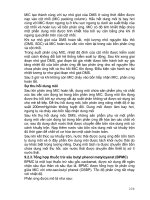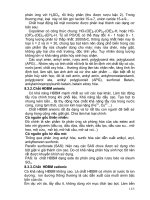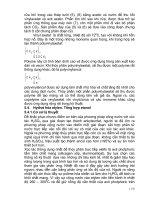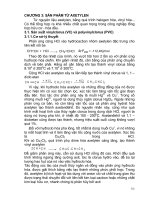Bai 9 x Tổng hợp hữu cơ hóa dầu
Bạn đang xem bản rút gọn của tài liệu. Xem và tải ngay bản đầy đủ của tài liệu tại đây (172.95 KB, 10 trang )
TỔNG HP HỮU CƠ &
HÓA DẦU
GV: ĐÀO THỊ KIM THOA
Bộ môn CNCB Dầu khí, Khoa CNHH, ĐH Bách
Khoa Tp. HCM
BÀI 9: HÓA HỌC TRÊN CƠ SỞ XYLENE
The term xylenes refers to a group of 3 benzene derivatives which
encompasses ortho-, meta-, and para- isomers of dimethyl benzene.
The o-, m- and p- isomers specify to which carbon atoms (of the main
benzene ring) the two methyl groups are attached. Counting the
carbon atoms from one of the ring carbons bonded to a methyl
group, and counting towards the second ring carbon bonded to a
methyl
group,
the
o-
isomer
has
the
IUPAC
name
of
1,2-
dimethylbenzene. The m- isomer has the IUPAC name of 1,3dimethylbenzene. And p- isomer has the IUPAC name of 1,4-
I. Giới thiệu:
Xylenes: dimethyl benzene.
Nguồn: reforming xt, cracking.
P- xylene: quan trọng nhất: tạo terephthalic
acid để tổng hợp polyester.
M – xylene: ít được dùng nhất: nhưng lại
chiếm tỷ lệ cao nhất trong hỗn hợp, thường
được isomer hóa thành p-xylene.
Hóa học chủ yếu trên nhóm thế methyl,
phản ứng oxy hóa.
65% xylenes dùng để tổn hợp hóa chất.
Phần còn lại: làm dung môi hay pha trộn
xăng.
It is a colorless, sweet-smelling liquid that is very
flammable. It occurs naturally in petroleum and coal tar
and is formed during forest fires. The chemical properties
differ slightly from isomer to isomer. The melting point is
between −47.87 °C (m-xylene) and 13.26 °C (p-xylene).
The boiling point is for each isomer at around 140 °C. The
density is at around 0.87 kg/L and thus is less dense than
water. Xylene in air can be smelled at 0.08 to 3.7 parts of
xylene per million parts of air (ppm) and can begin to be
tasted in water at 0.53 to 1.8 ppm.
II. Hóa học trên cơ sở xylenes:
1. Terephthalic acid (HOOC-C6H4 -COOH
) (TPA)
Terephthalic acid is one isomer of the three phthalic acids. It
finds important use as a commodity chemical, principally as a
starting compound for the manufacture of polyester (specifically
PET), used in clothing and to make plastic bottles. It is also
known as 1,4-benzenedicarboxylic acid, and it has the
chemical formula C6H4(COOH)2.
CH3
CH3
CH3
+
+
3 O2
COOH
3/2 O2
+
2 CH3-OH
CH3
CH3OOC
COOH
+
COO-CH3
HO
2
+
4 HO
2
Dimethyl terephthalate (DMT)
CH3OOC
COO-CH3
+
2H O
2
COOH
COOH
+
2 CH3-OH
Ứng dụng chính của TPAvà DMT: tổng hợp
polyester để sx sợi tổng hợp và film
Properties
It is almost insoluble in water, alcohol and
ether; it sublimes rather than melting when
heated. This insolubility makes it relatively
awkward to work with, and up until around
1970 much crude terephthalic acid was
converted
purification.
to
the
dimethyl
ester
for
Phthalic anhydride
Phthalic anhydride is the anhydride of
phthalic acid. It dissolves in alcohol and
some other organic solvents.
Phthalic anhydride is obtained either by
catalytic oxidation of ortho-xylene with O2
(oxygen)
or
naphthalene.
by
catalytic
The
oxidation
biproducts
of
of
the
napthalene reaction are carbon dioxide
and water.
It is hydrolyzed by hot water, forming
ortho-phthalic acid.
Phthalic
industry
anhydride
in
(rhodamine,
the
is
widely
production
anthraquinone
used
of
in
dyes
derivatives),
insecticides, plasticizers, in pharmacy, in
O
CH3
CH3
+
3 O2
C
C
O
+
3H2O
Hiện nay, phthalic anhydrideO chủ yếu đi từ
con đường oxy hoùa o-xylene
Xt: V2O5 + TiO2 /Sb2O3
To : 375 – 435oC
P: 0.7 atm
Hs: 85% phthalic anhydride
Phản ứng pha hơi
Ứng dụng: sx chất hoá dẻo, nhựa polyester
không no, nhựa alkyd.









